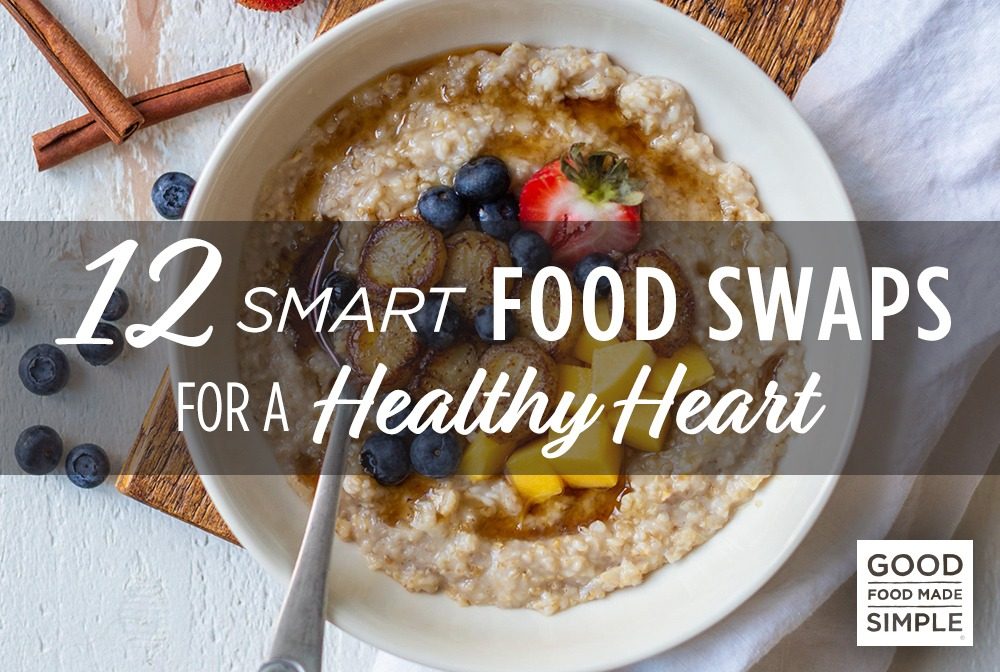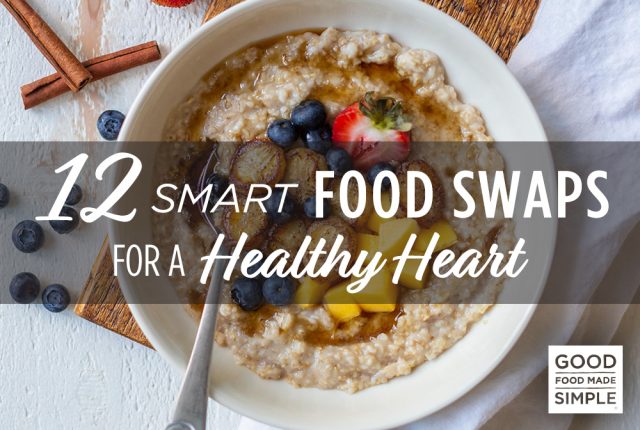
25 Active Date Ideas
While going on dates can certainly be fun, a typical night out with a romantic partner often ends up being focused on eating ...
read more
February is American Heart Month, and one of the best ways to maintain good heart health is to watch what you eat. Instead of depriving ourselves of delicious foods, we came up with some healthy swaps so you can still eat foods that will delight your taste buds, while also knowing you’re doing your body a favor.
1.Top your oatmeal with fresh fruit instead of sugar.
While a hearty bowl of oatmeal is a great start, we can add so much sugar to oats that it cancels out the health benefits. Instead of adding brown sugar or maple syrup, mix in fresh fruit to sweeten the oats up naturally while getting in some extra vitamins and minerals. For example, blueberries are an amazing topping since they are packed with vitamin C and manganese, along with antioxidants and anti-inflammatories that can keep your heart happy and reduce the risk of chronic diseases. Pro-tip: For any fruits you love that are hard to find fresh, peek in the freezer aisle and grab the frozen version.
2. Choose eggs over cereal.
Another way to kick off your morning on the right foot is to choose an egg–white sandwich (or keep the yolk!) over a bowl of cereal. Contrary to popular belief, an egg or two a day won’t lead to a dangerous spike in cholesterol. Instead, they are packed with protein, rich in vitamin D, B6, B12, and full of minerals like zinc, iron, and copper. This makes for a way better breakfast than cereal, which contains a lot of processed sugar and simple carbs.
3. Chow down on a homemade veggie burger versus a beef burger.
While meat in moderation is fine, our beef with beef is it’s high in unhealthy saturated fats, which has been connected to increasing “bad” LDL cholesterol. On the flip side, baking a homemade veggie burger means you’re in control of what you consume. Black bean and legume burgers are filled with protein and fiber without the extra fat. Chickpeas, sweet potatoes, and carrots are also great veggies to add to your burger. And not to worry; if you’re short on time, you can buy a premade veggie burger. Just make sure to read the label and watch out for added preservatives and sugar!
4. Add avocado versus mayo to sandwiches.
If you’re in need of a healthy condiment to spread on your sandwich, mashed avocado is a tasty substitute for mayonnaise. Avocado is rich in healthy monounsaturated fats that help lower inflammation and could also protect your heart. You’ll also get nutrients and fiber from avocados that you won’t get from mayo, which is filled with fats and oils.
5. Drink water with a splash of juice instead of fruit juice
If you want to stay hydrated but bored by your basic glass of water, add a splash of fruit juice to your glass versus drinking an entire cup of juice. You’d be surprised at how much flavor just a slash adds, giving you a tasty drink without all those extra calories from sugar.
6. Snack on walnuts (or any nut!) instead of chips.
If you’re craving a salty snack to hold you over until dinner, grab a handful of walnuts over chips. While chips contain sneaky amounts of saturated fats, walnuts are chock full of vitamin E and help boost your intake of heart-healthy omega-3 fatty acids — which are great for the heart, brain, and skin. Whenever possible, choose raw and unsalted nuts over the roasted and salted versions.
7. Eat grilled salmon instead of steak.
Like hamburgers, steak can also be filled with saturated fats which can elevate our levels of LDL cholesterol. For a heart-healthy superstar at the dinner table, a fatty fish like salmon contains a hefty amount of omega-3 fatty acids (the same polyunsaturated fats that are found in walnuts) which have been shown to benefit the heart and brain. Salmon is also an excellent source of selenium, an antioxidant.
8. Say so-long to white side dishes and enjoy green ones.
If you need some side dishes for a meal, skip the white starch — things like rice, potatoes, noodles, and bread. These foods could contribute to high blood sugar and could put you at risk for heart disease. Instead, fill your plates with greens like kale, broccoli, spinach, or brussel sprouts. You can steam them or saute them, roast ‘em or keep them raw. However you enjoy them, adding green vegetables to your plate can lower high cholesterol and reduce internal inflammation, two risk factors for heart disease.
9. Use spinach instead of iceberg lettuce in salads
Speaking of greens, add dark green leafy greens like spinach and kale to your salad over iceberg lettuce. While the latter is devoid of heart-healthy vitamins and minerals, spinach is rich in iron, vitamin K, vitamin A, and vitamin C, and also contains manganese, magnesium, iron, and vitamin B2. There is a reason Popeye is obsessed with spinach. You should be, too!
10. Use more spices and less salt when cooking dishes.
While there’s nothing wrong with a bit of salt, people often use that as their default spice when needing to add extra flavor to a dish. If you have an existing heart condition, it’s especially important to watch your sodium intake. So instead of salt, add spices like garlic powder, ginger, pepper, lemon juice, or cumin to your food.
11. Enjoy a glass of red wine instead of a soda.
You can thank us later for this one. If you want to sip on something with a meal, skip the sugary soda and enjoy a glass of red wine. Some studies show that moderate amounts of alcohol (that means one drink for women and two for men) can contribute to happy heart health, and may even improve good HDL cholesterol levels. Red wine also contains polyphenols, which can increase the good cholesterol in our bodies and decrease inflammation. Cheers!
12. Swap baked goods out for dark chocolate.
To satisfy the sweet tooth in all of us, grab a nice chunk of dark chocolate versus a batch of baked goods. Cookies and cakes are chock-full of sugar, hydrogenated oils, simple carbs, and sugar, whereas chocolate has a smaller ingredient list. Chocolate’s main ingredient, cocoa, contains flavanols that help lower blood pressure and improve blood vessel function. Even better, some small studies show that dark chocolate can improve health heart and lower the risk of heart disease! Just don’t go too overboard; enjoy a square or two from a bar, verses chowing down on the entire thing.
With these small swaps, you should see major improvements in your health. Focus on one healthy swap a day, and consider increasing the number of healthy choices you make as you go on. Before you know it, you’ll be eating better than ever before, while never sacrificing flavor.

25 Active Date Ideas
While going on dates can certainly be fun, a typical night out with a romantic partner often ends up being focused on eating ...
read more
12 Smart Food Swaps For A Healthy Heart
February is American Heart Month, and one of the best ways to maintain good heart health is to watch what you eat. Instead of...
read more
Starting the New Year With the ‘Right’ Mindset
With the holiday finally over and the new year upon us, I’d be shocked if you haven’t thought about New Year's Resoluti...
read more